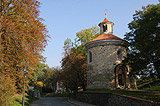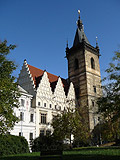The City Transformation in the Modern Age
 Many of the changes were of course results of wars. At this moment I wish to point out the major changes done decisively and coordinated from the centre of power or those dictated by an immediate need.
Many of the changes were of course results of wars. At this moment I wish to point out the major changes done decisively and coordinated from the centre of power or those dictated by an immediate need.
Firstly, many changes were politically motivated and ordered by the ruler or his administration. Many churches were abolished during the reign of Joseph II . The king was an enlightened, rational person and his overall record is fairly good. Unfortunately, his radicalism resulted into the fact that many churches and monasteries were closed down, turned into storages etc. About sixty monasteries and chapels were abolished in Prague alone. The fact that a church building lost its status often led to its decline, since problems with its funding and its purpose arose. This became easier over the years, as historicist sentiments gained in strength and old buildings, no matter whether useful or not, were suddenly considered valuable. It is this tendency to keep the old unchanged as a carrier of the place’s history that saved many buildings, which could have been considered useless from a strictly functional point of view.
The other kind comes form the simple fact that Prague was changing as an organism. It was expanding and it needed more facilities. Until this process started there were many parts of the centre which were quite empty and there was no organized shape of the river bank area. Every unused spot was to be occupied by a building, a road, a tower; bridges were built. The houses grew higher, balconies got attached.
 It was notably the nineteenth century which brought a major growth of the city, often as a result of speculation and massive interest in building and enlarging. The end of the century was the worst: during some twenty years, the face of the Old town was changed as much as possible. There was the demolition of the Jewish quarter and some streets in the center.
It was notably the nineteenth century which brought a major growth of the city, often as a result of speculation and massive interest in building and enlarging. The end of the century was the worst: during some twenty years, the face of the Old town was changed as much as possible. There was the demolition of the Jewish quarter and some streets in the center.
It were actually these several decades that motivated the birth of a number of civil organizations. Supported by architects and other cultural workers, the organizations, which could be, in contemporary language, called NGOs, started an ever going fight with the radical projects in historical Prague. How much was needed and how much was plain stubborn conservatism is always hard to distinguish.
Prague Olympics: Some Doubts XXXI. International Jazz Festival Prague